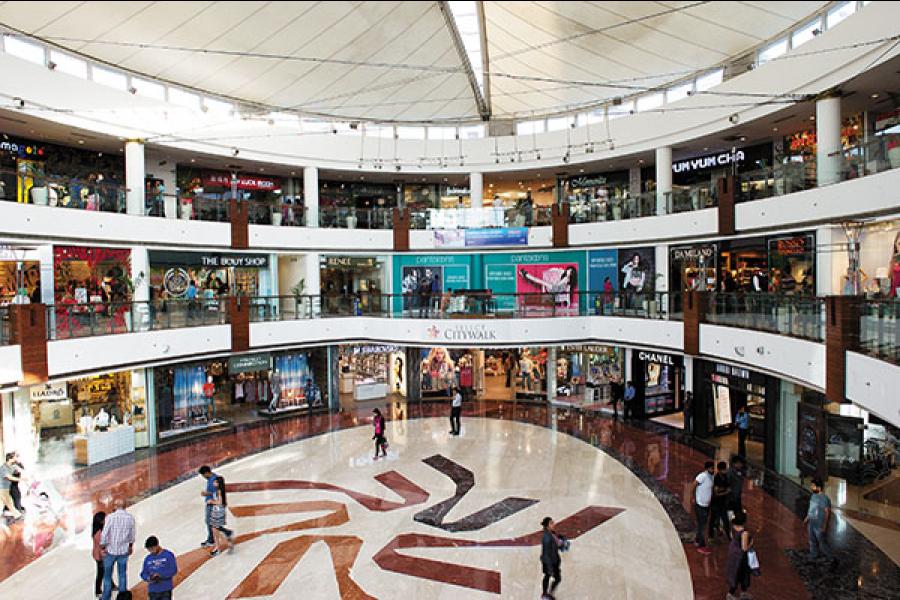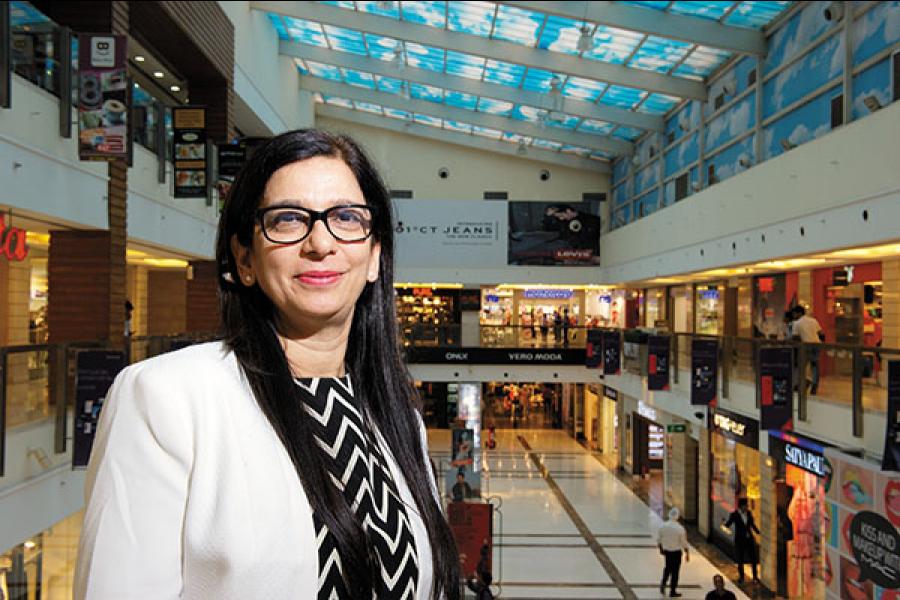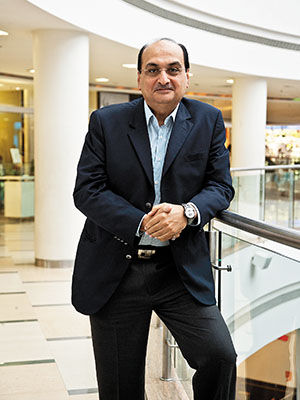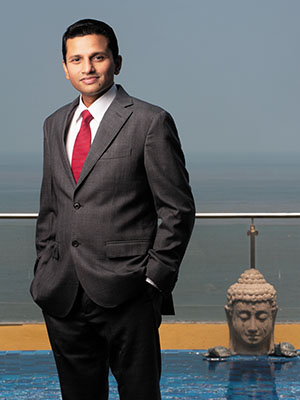
Behind the big fat Indian mall
Running a mall is not for the faint-hearted. But the struggle for financial viability, customer understanding and longevity may be over for some
In December 2011, Atul Ruia decided to pay a visit to a far-flung part of his empire. The owner of High Street Phoenix in Mumbai caught a flight to Lucknow, and arrived at the Phoenix United Mall there. He had developed the mall with a partner and had thus far maintained a hands-off approach.
He was shocked by what he saw. On the afternoon of his visit, the mall had a special visitor. Bollywood actor Shah Rukh Khan was travelling to Lucknow to promote his latest film Don 2. For a city with few avenues for entertainment, this was a big-ticket event and they turned out in droves.
When Ruia reached the mall, it was bursting at its seams. There was no place to stand and crowd management had already become a challenge. The mall manager, in his rush to monetise every square inch, had left few areas open. “Women were feeling unsafe and were exiting the mall,” recalls Ruia. Perturbed and let-down, he went to a rival mall and sat down with a cup of coffee. He had come away from the experience with plenty of food for thought.
That is not to suggest diminishing relevance of malls in modern-day lifestyle. Consider that malls have become the chosen avenue for organised retail—according to the Shoppers Stop annual report, the industry stands at around $40 billion and is expected to touch $95 billion by 2018, and will account for 10 percent of the overall retail industry in the country. The next wave of expansion will be spread across the country and wherever the new players mushroom, the learning curve of their large city counterparts will provide an invaluable manual of dos and don’ts. After all, as malls and mall developers have emerged and grown, they have got their hands dirty, suffered a few bruises. And, in the process, they have understood that this is a business that requires patient capital, a thorough understanding of the customer and the willingness to experiment.
For instance, Ruia, who has over-a-decade’s worth of experience in managing malls, did not react hastily to the situation at his Lucknow establishment. Instead, he decided to wait and come to a considered conclusion. He realised that footfalls were not all that mattered. There were plenty of other things that he needed to do to get the mall into shape to attract the right footfalls. And so he rolled up his sleeves and got to work. Store sizes were changed. The retailer mix was re-evaluated. More open spaces were created. It took him around two years to get the mall back into shape.
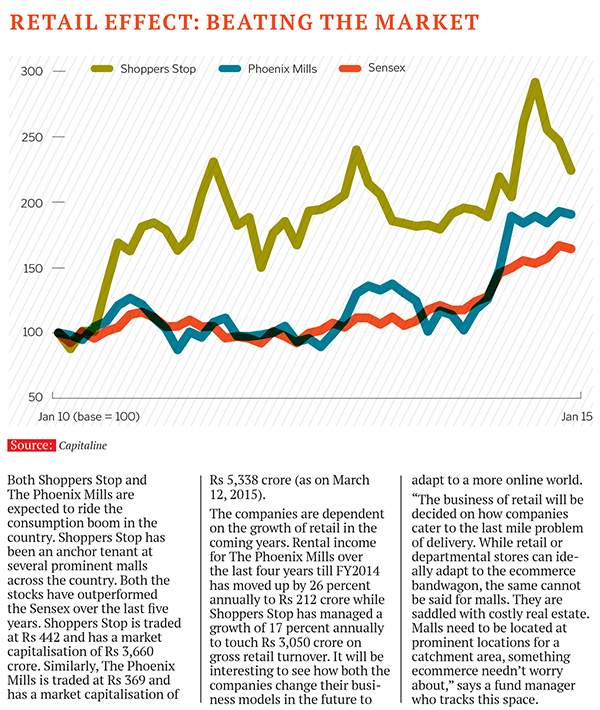
Like Ruia, mall owners across the country have evolved operating models that increase financial viability and ensure longevity. This, Forbes India found through extensive reporting, typically accounts for flexibility in the constituents of the establishment; optimal revenue share with tenants; a hands-on approach to mall management; and, critically, a long-term approach to capital invested. Popular wisdom suggests location and design as defining factors. But, as mall owners have discovered through trial and error, they are only the starting point. And, significantly, it isn’t a once-size-fits-all business, as Subodh Runwal proved early on in Mumbai.
In 1998, when the developer returned to Mumbai after his MBA from the Northeastern University in Boston, US, he found the city lacking in retail spaces. The lone operating mall at the time was Crossroads (currently Sobo Central) in south Mumbai. There was nothing for anyone who lived beyond central Mumbai. That was the opportunity, he says. “I wanted to build a mall for middle-class Indians—a mall where the entire family could go to dine, shop and entertain,” he says.
The Runwals had a flourishing real estate business at the time but, even so, when he talked about building a mall in Mulund, a far-eastern suburb of Mumbai, there was a sense of disbelief. And not just from his family. “When we opened, a majority of the shopping malls around the country were struggling. So when I started talking to vendors that I was planning a 4 lakh square feet shopping mall, they were skeptical since many big malls had flopped by then,” says Runwal. It was eventually decided by the Runwals that they would hedge the mall business by building three residential towers behind it. “This would act as a cushion if the mall business got into trouble,” he says.
By 2003, R-Mall was up and running, and thriving, says Runwal. “It was a great middle-class location,” he says. And that has been his strategy since: He has targeted the more middle-class localities of Mumbai, even to the extent of “over-supply”. He has two R-Malls within kilometres of each other, in Mulund and adjacent Thane. Similarly, R-Odeon and R-City are both in Ghatkopar.
His approach is diametrically opposite to that of the other pioneer, Atul Ruia, the man behind Phoenix Mills in Lower Parel, the mall that is the accepted standard in shopping experiences in India. While Runwal believes in bringing in more footfalls and converting them into customers, Ruia focuses on the quality of the footfall.
But neither the quality nor the quantity of footfall can guarantee profitability. And that has been the challenge for mall-owners, including Ruia and Runwal. They, like all other mall managers, have spent much of the last decade in an urgent attempt to understand the business. Revenue maximisation cannot be the main objective, they realised. “A mall is an asset that has to be monetised across its life cycle. People make the mistake of fixing rentals too high initially and that compromises on the tenant mix,” says Bhatija of the K Raheja Corp-owned Inorbit.
The need for regular churn in the retailer mix emerged as critical. Most malls are in an environment where consumers have become shape-shifting animals and understanding them is a complex process. Then, it normally takes around five to seven years for a mall to get completed—from its planning stage to the final, brick-and-mortar avatar. In this time, the economic cycle can change and, along with this, there will inevitably be an evolution in consumer taste.
Benu Sehgal, who is the mall head of DLF Saket Place in New Delhi, says, “Typically, 50 percent of the leases are for five years, especially those with strong brands like Zara and Mango. It is the balance 50 percent that needs to be planned carefully.” These shorter-term retailers need to cater to shifting customers. A mall manager who declined to be named says, “Sometimes we have to ask brands to leave for no fault of theirs, as customer tastes change.”
Disparity in tastes also cuts across different cities, where customers have their own peculiarities. While Bangalore has seen international retail do well compared to other cities in India, Chennai still is a local market. (See Split of Modern Retail Space down) RR Aroon Kumar, CFO, Express Infrastructure Private Ltd, which owns Express Avenue Mall in Chennai, says, “Chennai historically has had a strong retail base. It has been the home to many retail experiments for decades. But in terms of malls, Chennai has a major short supply. For a city of this size, there are only four or five large malls. Last year, no new mall was added and there are no projects in the pipeline in 2015 and 2016.” But that does not mean Chennai is a bad market for malls, he adds. “Our average sales-per-person has seen a double digit growth in 2014-15 compared to 2013-14. I refuse to accept that Chennai is too conservative a market for malls to be successful. It is true that Chennaites do not spend like people in Delhi or Mumbai. This disadvantage is compensated by other advantages like lower real estate and other costs,” he says.
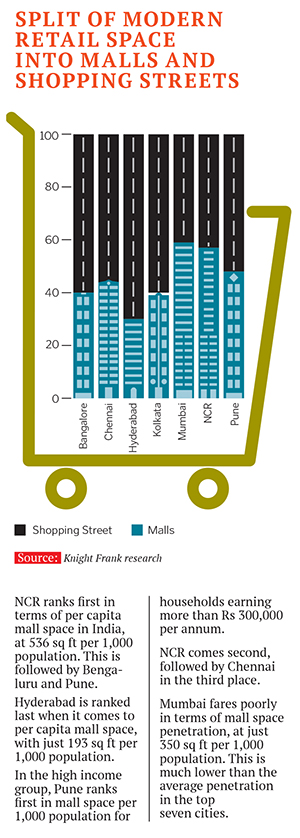
And rightly so. Location does play a key role in determining “occupier mix”. South Delhi’s Saket Select City Walk chose to position itself as a “neighborhood fashion mall”, says Yogeshwar Sharma, executive director. “We chose to be in the fast fashion space and consciously stayed away from high-end brands. Our challenge was to provide brands that are both lifestyle and aspirational to our customers who belong to the middle- and upper middle-class segments,” he points out. In fact, location was the big draw for the promoters of the mall, which is a JV between developers, the Select Group and the Aarone Group. “This was the last district centre to be auctioned in South Delhi. We bought the land for over Rs 200 crore and the total cost of the mall was over Rs 500 crore. The mall has been in operation for seven years. We achieved break-even recently and are now profitable,” says Sharma.
It has proved to be a formidable competitor to DLF Place in the same locality. But, despite the rivalry, Sharma and Sehgal seem to have struck an interesting relationship, in the face of the obvious disparity in their current fortunes with Select City Walk clearly ahead. “We compete but we also complement each other. The gates between the malls are opened up on weekends and festivals. We share parking, we don’t offer the same brands and we visit each other often,” says Sehgal. Sharma, meanwhile, calls Sehgal a “dear friend”. “We give each other suggestions. If we don’t have space for a brand, I tell her about it,” he says.
Now, while DLF Place is currently looking to reinvent itself, many others, who get affected by the over-abundance of malls in the same neighbourhood, tend to opt out of the business altogether. Cut to the Mulund-Bhandup belt in Mumbai, where, while R-Mall continues to thrive, Nirmal Lifestyle, Magnet Mall and Dreams Mall, set up just a few kilometres away from each other, are struggling. Nirmal Lifestyle wants to establish a residential space and a new mall after wiping out the existing footprints of the dome-shaped mall that was a local attraction in the mid-2000s. Dreams Mall is giving way to a hospital and Magnet Mall is up for sale.
The malls that are closing or rebuilding are typically first-generation ones. In some of those cases, most prominently Atria Mall in Worli, design has often played party-pooper. “You need to understand the catchment. But before that one needs to get many other things right and that includes design of the mall which is very important,” says Runwal, who quickly draws a sketch of R-Mall and explains the dynamics of mall design in a Mumbai minute. He also does another sketch of R-City, Ghatkopar, where he hosts Kidzania, an edutainment experience for kids. “I’m not an artist. But I can draw the sketch of my malls and how customers can experience the same,” he says.
By the same token, however, Suresh Singaravelu, executive director, retail, hospitality and business expansion, of the Bangalore-based Prestige Estates Projects Limited, points out that “the type of malls that we have built in the past, I don’t think we can do that anymore”. He says, “If you go and stand in front of any mall in this country, you can close your eyes and say which shop will be on the ground floor, the first floor and who will be the anchor of the mall. It is easy to know which floor will have the food court and the multiplex. The whole setup has become extremely predictable. Only the colour and interiors get changed. We have not seen a fundamental change in malls, as if nothing has changed in the last so many years, and consumer behaviour has continued to be the same.”
All of this adds up to a steep—very steep—learning curve. And even as they crawl, at varying speeds, upwards, they have started to face competition from an unexpected source: Ecommerce. While it has long been considered a rival which was waiting in the wings, they had not expected it to emerge with the ferocity it has shown; online shops over the last 18 months have been wooing customers through sales and discounts to attract the average mall shopper. Categories most affected include electronics as well as apparel (that sells for below Rs 1,000). Ecommerce shops do not have the brick-and-mortar expenses of on-the-floor staff and store aesthetics; their primary need is for top-class logistics services. And, as a consequence, ecommerce players like Snapdeal and Flipkart have become the poster boys of retail as they attract a profusion of funding from the private equity sector.
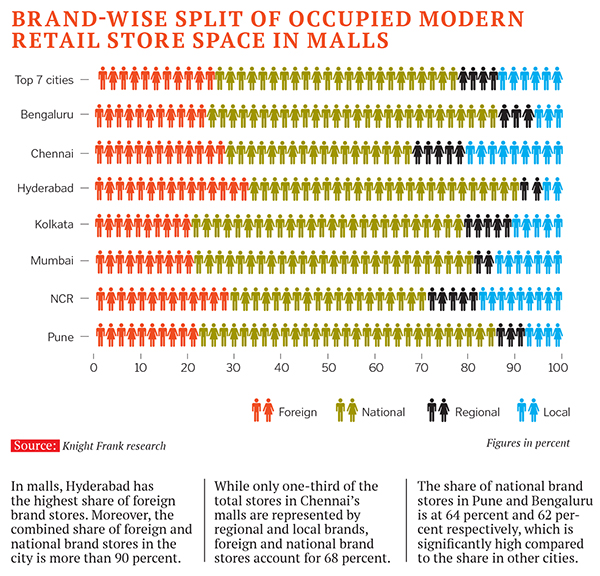
Malls still aren’t quite sure about how to judge the impact of ecommerce on their business. “Ecommerce in electronics is a worry but I think that, as of now, it has had a spillover effect because all the front page advertisements of electronics retailing have helped our store to actually pick up in terms of sales. But it could be a short-term thing,” says Deva Jyotula, general manager, Korum Mall, a neighbourhood mall in Thane. The 3 lakh sq ft mall is rezoning itself to concentrate on food and beverage (F&B) and the entertainment space by adding another 10,000 sq feet focussed on these areas. A homing area in a mall is the goal for him, as has been the case with successful mall-runners across the country.
They call it the ‘anchor store’.
Even before he broke ground at his Mulund mall, Runwal had tied up with Kishore Biyani to bring in a Big Bazaar store to his offering. This was after Ruia had set up the first Big Bazaar at his Phoenix Mills destination in Lower Parel. In fact, it is believed that Biyani had made it clear to both the malls that parking had to remain free for the next five years for him to set up his supermarket brand. Both had agreed. Apart from Big Bazaar, both the developers moved to bring in stores based on their target customer base—for instance, the Dubai-based Landmark Group’s Lifestyle departmental store. Phoenix Mills, given its south Mumbai catchment, also targeted premium brands. Other anchor stores across malls include Shoppers Stop, Zara, Hypercity and Spencer’s, among others. F&B brands like McDonald’s, Subway, Pizza Hut, etc, can also serve the same purpose.
“Anyone who says I will do away with the anchor stores and survive is lying. There is no formula where you can say you can manage without an anchor store because without it you become a shopping arcade and not a mall. If you leave out marketing, which contributes towards 5 percent of footfalls, everything else is crafted carefully by the anchor stores,” says Sehgal of DLF Place, Saket, who has earlier worked with the Appu Ghar Project and was involved with the Worlds of Wonder amusement park in Noida.
At the same time, Ruia says that with time he has learned that the mall has to be the main anchor. “The penny really dropped for me when I visited Dubai and saw a mall with only anchors empty. Another mall with smaller stores was full. Since then I have believed that the mall has to be the main anchor,” he says. Bhatija of Inorbit says that while it is tough to generalise, the department store format has shrunk globally and this has resulted in their diminishing importance as anchors.
Even trickier for mall owners is the leasing process of shops. This, ultimately, is what decides failure and success. Simply put, revenue maximisation is the certain route to failure. As a rule, developers lease the asset and work towards maximising revenue over the life of the asset. It is only when the mall gains some traction that developers can up the rentals.
During the initial boom phase, developers would sell shops, for instance Atria in Mumbai and DLF City Centre in Gurgaon.
Almost all those malls have failed. Sehgal has headed malls which are hybrid—where some of the shops are sold and others are leased. She had also worked on a mall which operated on a completely sell-model. According to her, “the rental model is better because that way I have control over the retail I want. Once I have sold space in malls, it becomes a problem because the buyer may not be interested in retail. They are typically investors. Malls will be successful if shops are leased. This helps the mall manager control the environment, ensure the right tenant mix, and also shut down shops that are not doing well and replace them with new ones.”
Initially, malls would agree on a fixed rental but things changed after the 2008 slowdown. With tenants unwilling to pay a fair rental, malls moved to a revenue share model so that the interests of both parties were protected subject to a minimum floor. This is an arrangement that has worked well. “Mall operators are more comfortable extending revenue and no minimum guarantee deal to global iconic brands,” says Jaspal Singh Sabharwal, partner at Everstone Group, which is part owner of Burger King’s India franchise.
For deciding which brands to bring into the mall, Ruia follows a simple rule: He observes what women like and what they are buying. “The woman is an aspiring customer. She moves from a mass store to a premium stage as her economic condition improves,” he says. “She moves from a Pantaloon to Superdry. But what is interesting is that she does take a stop with a bridge brand and stays there for a long time. This brand could be Calvin Klein or a Steve Madden.” Tracking the customer in this journey is not easy, he points out. It also a lot do with the catchment it caters to, he says.
While a Lower Parel in Mumbai can dedicate itself to premium and be profitable, the same strategy does not work in other parts of the city. Thane’s Korum is a neighbourhood mall and Viviana, in the same area, is a destination mall of around 1 million sq feet: The challenge for both is to remain relevant by being local and yet providing an international experience. Internationally, a large successful mall has 30 to 40 percent of its tenants as local retailers and brands. And, then, some more.
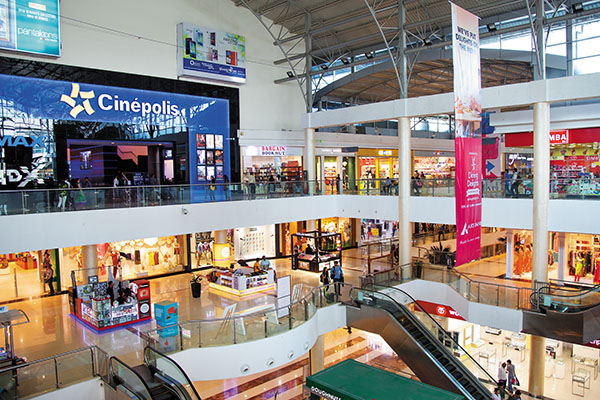
Neither the quality nor the quantity of footfall can guarantee profitability for mall owners
“If you take the successful malls in places such as Thailand, Indonesia, and Philippines, they provide all the requirements and services that are required. Malls have a chapel, mosque, child-care centre, wedding or community hall, clinics and other services. A mall is not supposed to be a place hosting only retail stores. Larger malls in metros are supposed to service the need of a community which is not just food, fashion and movies,” says Amit Bagaria, founder-chairman & CEO, Asipac, a Bangalore-based mall development consultant.
“The idea is to make it into a community centre where people can come with their families and spend time at the mall. Many of our visitors are now international travellers. We want them to give them that international experience closer to their home,” says Sunil Shroff, vice president, mall operations, at Viviana Mall, a subsidiary of Sheth Developers and Retailers. For him, it is important to attract footfalls which can later be converted into loyal customers.
“Focusing on local brands in a mall depends on how traditional the market is. The more traditional the catchment, the presence of the local brand immediately goes up in that mall. We would like to bring in strong local brands in malls which are located in traditional markets such as Chennai,” says Singaravelu. For instance, at the Forum Vijaya Mall in Chennai, almost 30 percent of the brands are local.
A decade-and-a-half into the first malls getting established in the country, it is clear that this is not a business for anyone with money to invest. Staying power and adaptability are key and, for those that didn’t get it right, “reorientation is a very critical part of the correction,” says Susil Dungarwal, chief mall mechanic at Beyond Square Feet, a mall advisory company. He also sees a fair amount of consolidation in the next few years with larger players buying out smaller malls in prime locations. For instance, Atria in Mumbai is ripe for a takeover. But one thing is clear: Malls are a reality, interwoven into urban life and community drivers. Only a few will survive and they will be those who are prepared to reinvest and reinvent.
(With inputs from Debojyoti Ghosh, Deepak Ajwani & N Madhavan)
(This story appears in the 03 April, 2015 issue of Forbes India. To visit our Archives, click here.)
-
 Naveen
Naveenthe conclusion is , success of shopping mall depends on location, consumer behavior of the particular area, design and maintenance, size of shopping mall and the final thing is tenant.
on Mar 30, 2015
